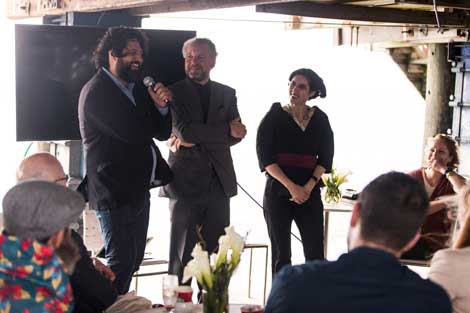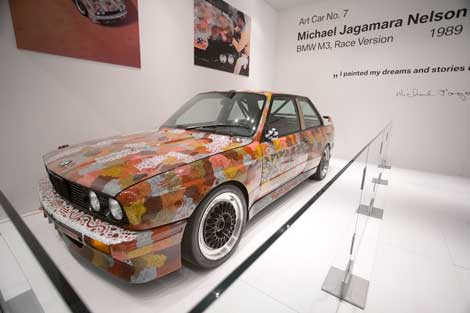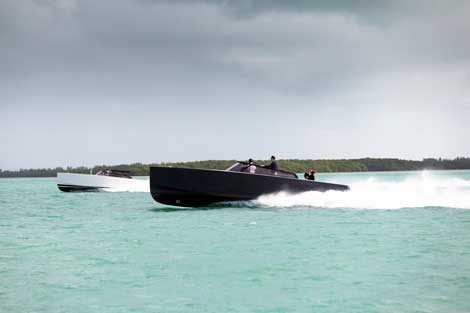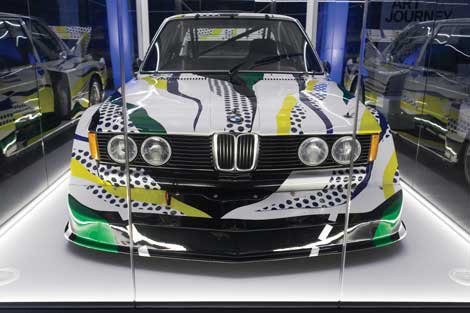The secret to a successful trip to Art Basel Miami is not the fair itself, but getting in on the hoopla created by the other events that surround it. Artillery did just that when invited to join an exclusive BMW art caravan—the purpose of which was not divulged to us until two days in. All we knew as we left home was that the car company was to launch a new initiative, the scale of which had not been tested before.
The junket opened with dinner at the Metropolitan, one of Miami’s recently refurbished Art Deco hotels. Here, we met Dr. Thomas Girst, an actual Bavarian appointed to lead our group of international art and auto writers. He may have one of the best jobs ever—Head of Cultural Engagement at BMW; he’s also a doctor of art history, a Duchamp scholar and author of four books. Girst is an enthusiastic host and generates genuine excitement as he lays out an itinerary of art-related tours, learned speakers and fancy receptions for the next few days. Girst jokingly makes a point to assure us that this is not philanthropy; BMW gets plenty of brand placement and visibility for their initiatives.

Members of the Miami Beach jury for BMW’s Art Journey, Juan Gaítan (Curator based in Mexico City, left) and Victoria Noorthoorn (Director Museo de Arte Moderna, Buenos Aires, right) speak with BMW’s Dr. Thomas Girst about their involvement with the new program
Yes, BMW considers art as part of its corporate pedigree. In fact, BMW Art Cars are a 40-year tradition that actually originated on the racetrack. The first BMW art car was painted by Alexander Calder in 1975. To date, 17 art cars exist and reside in the BMW Museum in Munich. Frank Stella, Andy Warhol, Robert Rauschenberg, Jenny Holzer, Olafur Eliasson and, recently, Jeff Koons have all had a hand in their creation.
Cut to Art Basel Miami 2014, and we get to see the Roy Lichtenstein car from 1977, the third in the art car series. The BMW 320i is unveiled at night in a botanical garden, amidst cocktails. The design depicts “the countryside, what the car would see, sun and trees,” in Lichtenstein’s signature comic book style. The next day we find Michael Jagamara Nelson’s M3 inside the Art Basel convention center, on display in the U.S. for the first time. The esteemed Australian Aborigine artist created his car in 1989 with Papunya shapes and patterns, including mystical renderings of water, opossum and kangaroos.

Michael Jagamara Nelson’s BMW M3 Art Car, seen for the first time in the U.S. at Art Basel Miami 2014.
By the fourth day we have listened to artists and curators talk about “art and place,” seen some of the most significant art of the 20th and 21st century, rolled the Miami streets in style and finally, power-boated through wind and a brief rainstorm to Stiltsville in Biscayne Bay, our destination being one of seven Prohibition-era forts amid the waves. Here, surrounded by turquoise skies, a glittering ocean and a flock of seabirds, we finally get down to why we’re really here. In 2015, Art Basel and BMW will recognize emerging artists with the BMW Art Journey. Structured a bit like a Ted Prize, the loosely defined offering invites an emerging artist to propose a trip of a lifetime. Artists who are exhibiting in Art Basel’s “Discoveries” sector in Hong Kong, and the “Positions” sector for emerging artists in Miami are eligible for one of the two journeys presented per year.

The Van Dutch speedboats that ferried Artillery to BMW’s Art Journey adventure press breakfast were works of art as well.
Perhaps most impressive is the lineup of jurors who will select the winners. Included among the judges are the directors of the Guggenheim Museum in New York, the Asia Art Archive in Hong Kong; the Städtische Galerie im Lenbachhaus, Munich; the Artistic Director at New York’s New Museum; the director of the KW Institute for Contemporary Art in Berlin; and the director of Museo de Arte Moderna in Buenos Aires.
When pressed for specifics, Dr. Girst explains that there is no timeline, and “if an artist wants to take 10 years to create something from their experience, they can.” The work is sold, or not, again at the artist’s discretion, with BMW claiming no ownership of it after the trip. BMW will be satisfied with documenting the journeys and promoting the venture via social media and other outlets, Girst promises.
On the plane back to LAX, we ponder the confluence of creativity and corporate sponsorship. There is an opening quote on the cover of BMW’s Zagat-like art collections guide, set in stark black Helvetica and printed on white, velvet toothed paper, that asks, “If no one ever looked at art, would anybody even create it?” The automakers have done all they can to make sure we’re looking, even if the circular blue and white logo looms quietly in the background.


